Even Yu Shi, god of rain, takes a vacation once in a while, removing the gray cloak of clouds that long segregated heaven and earth.
A week’s worth of drizzle is fast evaporating as residents emerge from their homes with the look of creatures awoken from hibernation.
With azure skies overhead, everyone, it seems, will be heading to the hills and coastal parks that arc Taiwan’s capital and its satellites.
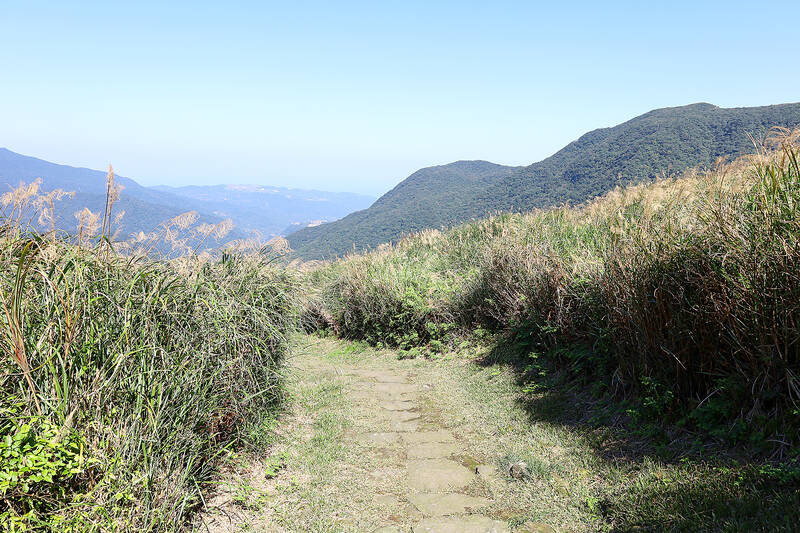
Photo: Thomas Bird, Taipei Times
“It’s going to be busy, no matter where we go,” I say to Tamsui resident Mathias Daccord, noting the succession of cyclists already taking advantage of the fine morning weather.
“Don’t worry, I know a hiking trail that’s quite steep, so it seldom gets crowded,” the Frenchman says.
While still chewing the last mouthfuls of breakfast, we bundle into the car. The drive alone proves worthy of the rush. The road snakes its way out of town, past villages and farmsteads and into the foothills of Yangminshan (陽明山), the forest-coated mountain park that dominates the head of Taiwan. The air is profuse with the scent of lush vegetation.
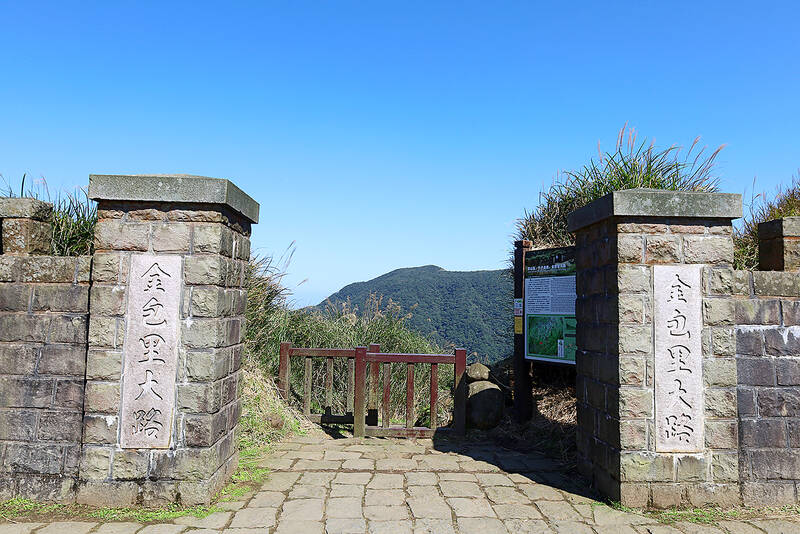
Photo: Thomas Bird, Taipei Times
No sooner does Daccord mention that, “We sometimes see monkeys on this hike,” two Formosan rock macaques, a mother and infant, appear roadside. “You see,” he says, slowing down to salute our new simian friends.
We park near Shanghuang Creek (上磺溪), close to one of the entrance points the Jinbaoli Historic Trail (金包里大路). As Daccord promised, there isn’t many people about, bar a few keen dog walkers.
That said, we’re following a well-beaten path, one that, according to some informative path-side plaques, was first carved out of the forest by “indigenous tribes to travel from their villages and forge marriage alliances.”
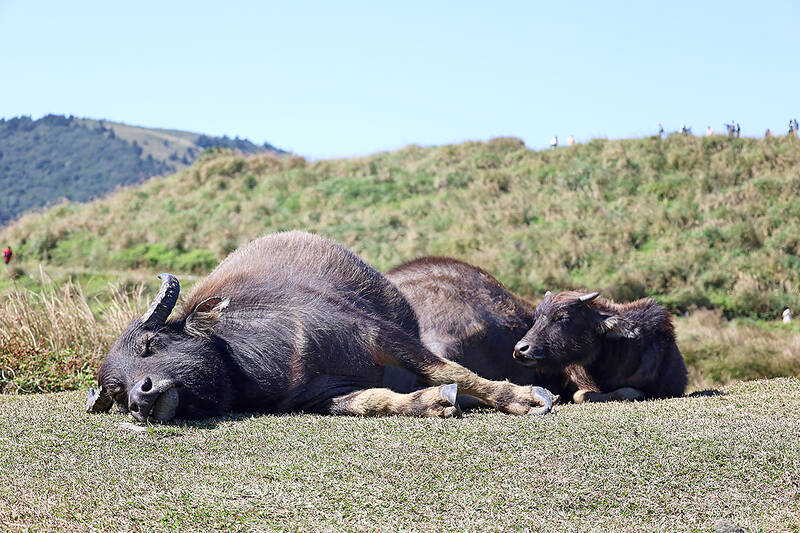
Photo: Thomas Bird, Taipei Times
STRATEGIC PASSAGE
It was Fujianese fishermen migrating across the strait during the Ming and Qing eras that turned these ancient trails into something of a tea road, “a transportation route between Jinshan and Shilin” districts, where goods like “fish, tea and indigo” were carried via buffalo cart or bamboo pack basket.
The strategic passage would later be coopted by Qing soldiers from North China who were sent to pacify rebellions and safeguard the sulfur mines that were essential for gunpower production. After Japan acquired Taiwan in the wake of the Sino–Japanese War of 1895, the colonial administration built “a winding trail” in order to “transport canons,” which is known today simply as the Japanese Road (日人路).
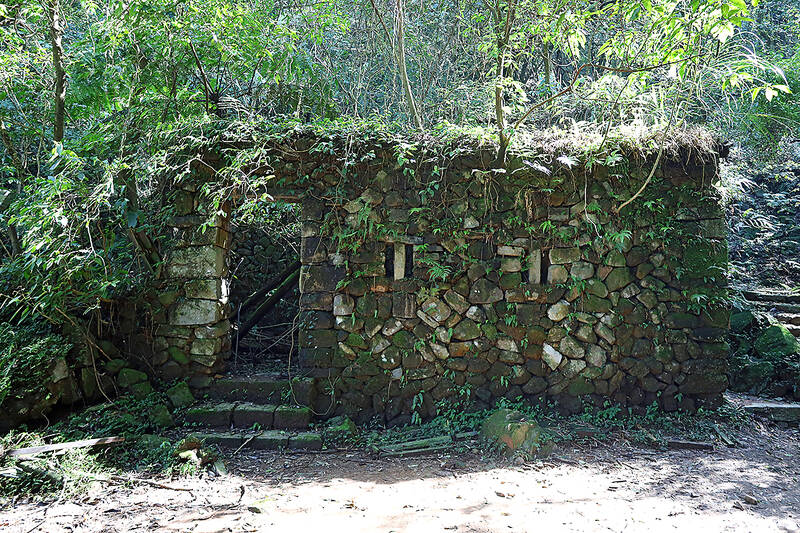
Photo: Thomas Bird, Taipei Times
“The Japanese Road intersects the trail at various points,” explains Daccord as we follow a stone path through a heavily wooded area. “We can follow back down once we reach the top.”
Along the way, streams gush through the woodlands, heavy with a weeks’ worth of rain. Shafts of light bisect the branches. The sound of the water cascading down the hill, combined with birds tweeting from the tree canopy, is pure tonic for those who’ve been immured in urban environs for too long.
There are remnants of the “highway” that was lining the route, moss-covered ruins of buildings and walls from earlier times, including Xuyan Bridge, where we stop to rest. This lovely stone overpass was first built across the creek in 1896 by a wealthy local tea merchant in order to help move his product to buyers on the other side of the range.
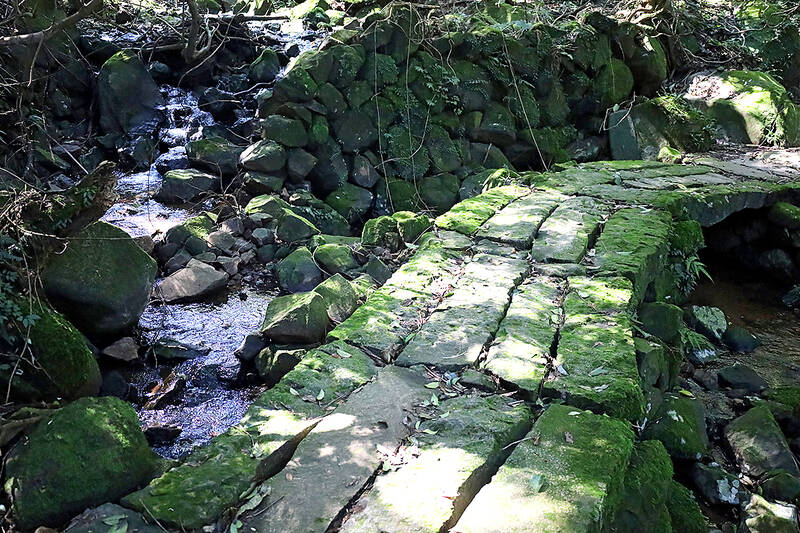
Photo: Thomas Bird, Taipei Times
As we press on, we observe evidence of farms that must have once existed, terraced fields still definable stepping the hillside despite mother nature’s best reclamation efforts.
Eventually we emerge from the shade of the forest cover onto an open path lined by tall grass. The gradient is much steeper once we pass the “Master Stone” –– a giant boulder long used as a boundary marker, and begin to climb the 120 stone steps that lead to the summit.
I periodically stop to catch my breath and enjoy the view, a vista of verdant valleys and sharp ridges stretching towards the deep blue horizon.
‘HILL HOLDING UP HEAVEN’
Reward for our hour-long ascent is to arrive at Qingtiangang (擎天崗), a grassland that goes someway to explain why Yangmingshan had been known as Caoshan (草山) or Grass Mountain before 1950, when former president Chiang Kai-shek (蔣介石) decided to rename the mountain park after a famous Ming Dynasty scholar.
Qingtiangang translates as “Hill Holding Up Heaven,” a poetic, somewhat honey designation no doubt, but one it duly deserves. It’s a spectacle to behold, a flat, saddle-shaped area formed by lava flow from Zhugao Mountain (竹篙山) and encircled by four major peaks. It was the Japanese that turned it into a cattle ranch and tea plantation, although only a heard of water buffalo lazing in the winter sun allude to any kind of agricultural legacy today.
Administrative lines converge on the grassland as it lies in both Taipei’s Shilin District (士林) and New Taipei’s Jinshan District (金山). It is also where a number of trails and roads meet, which probably accounts for the number of weekend walkers we encounter. Still, despite the pedestrian scene of families taking selfies, one still has to pinch ones self when considering that their ambling across a meadow 770 metres above sea level carpeting a lava terrace.
We rest beside the reconstructed Jinbaoli Trail Gate, which, according to legend, was first built by famous anti-Japanese rebel leader Big Lion Jian (Jian Da-shi, 簡大獅). However, as another informative sign reads, “in the end he could not resist the overwhelming Japanese forces…” Jian surrendered in 1898, was enlisted in a road building project but went on to cause more trouble and thus met a premature end in 1900.
With some sense of poetic solemnity, then, we make our way back to the car via the Japanese Road. It is broader, smoother, if slightly longer than the original trail, as it traces the contour lines of the hillside.
Before we reach tree cover again, we’re treated to more incredible views of north Taiwan’s topography. It would be a cloudless scene, were it not for the volcanic vapors rising from fumaroles, the breath of the mountain cast into the air high above New Taipei.
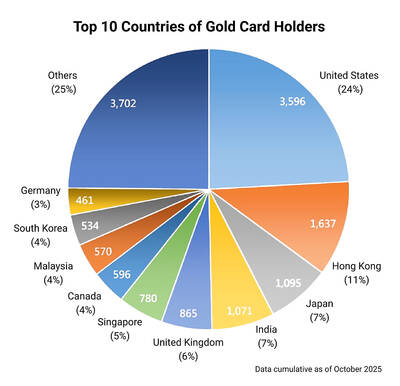
Seven hundred job applications. One interview. Marco Mascaro arrived in Taiwan last year with a PhD in engineering physics and years of experience at a European research center. He thought his Gold Card would guarantee him a foothold in Taiwan’s job market. “It’s marketed as if Taiwan really needs you,” the 33-year-old Italian says. “The reality is that companies here don’t really need us.” The Employment Gold Card was designed to fix Taiwan’s labor shortage by offering foreign professionals a combined resident visa and open work permit valid for three years. But for many, like Mascaro, the welcome mat ends at the door. A

If China attacks, will Taiwanese be willing to fight? Analysts of certain types obsess over questions like this, especially military analysts and those with an ax to grind as to whether Taiwan is worth defending, or should be cut loose to appease Beijing. Fellow columnist Michael Turton in “Notes from Central Taiwan: Willing to fight for the homeland” (Nov. 6, page 12) provides a superb analysis of this topic, how it is used and manipulated to political ends and what the underlying data shows. The problem is that most analysis is centered around polling data, which as Turton observes, “many of these

Since Cheng Li-wun (鄭麗文) was elected Chinese Nationalist Party (KMT) chair on Oct. 18, she has become a polarizing figure. Her supporters see her as a firebrand critic of the ruling Democratic Progressive Party (DPP), while others, including some in her own party, have charged that she is Chinese President Xi Jinping’s (習近平) preferred candidate and that her election was possibly supported by the Chinese Communist Party’s (CPP) unit for political warfare and international influence, the “united front.” Indeed, Xi quickly congratulated Cheng upon her election. The 55-year-old former lawmaker and ex-talk show host, who was sworn in on Nov.

Divadlo feels like your warm neighborhood slice of home — even if you’ve only ever spent a few days in Prague, like myself. A projector is screening retro animations by Czech director Karel Zeman, the shelves are lined with books and vinyl, and the owner will sit with you to share stories over a glass of pear brandy. The food is also fantastic, not just a new cultural experience but filled with nostalgia, recipes from home and laden with soul-warming carbs, perfect as the weather turns chilly. A Prague native, Kaio Picha has been in Taipei for 13 years and